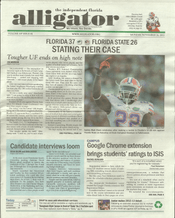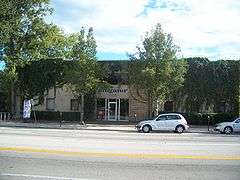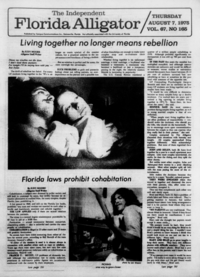The Independent Florida Alligator
 | |
| Type | Weekday newspaper |
|---|---|
| Format | compact |
| Owner(s) | Campus Communications Inc. |
| Publisher | Campus Communications, Inc. |
| Editor | Ariana Figueroa |
| Managing editors |
Mary Grace Henley Emily Cochrane |
| Sports editor | Ian Cohen |
| Founded |
1906 1971 (as independent paper) |
| Headquarters | Gainesville, Florida |
| ISSN | 0889-2423 |
| Website | www.alligator.org |

The Independent Florida Alligator is the daily student newspaper of the University of Florida. The Alligator is the largest student-run newspaper in the United States, with a daily circulation of 35,000 and readership of over 52,000.[1] It is an affiliate of UWIRE,[2] which distributes and promotes its content to their network.
The paper prints every weekday during the spring and fall semesters (mid-August to early May) and on Tuesdays and Thursdays during the summer semesters. The Alligator has been financially and editorially independent from the university since 1973. The Alligator has been owned by non-profit, student-controlled 501(c)(3) Campus Communications Inc. since its independence. Students from both UF and Santa Fe College, also located in the city of Gainesville, Florida, are allowed to work at the paper. Only college students are allowed to work in the editorial department or be advertising representatives or interns.[3]
The Alligator is distributed free on campus and around the city of Gainesville, Florida, and contains a mix of campus and local news coverage, as well as national and international stories from wire services. It also contains a sports section that begins from the back of the tabloid-format paper, and an entertainment section ("The Avenue") published every Thursday. The Alligator prints on 11 x 14 inch paper, somewhat smaller than a tabloid size, closer in size to the compact format of The Times of London and the Chicago Sun-Times.
History
Early history
The Alligator began as an independent student-run newspaper called The University News, on October 19, 1906. The paper came together in time to report on the University of Florida's opening ceremony in its new permanent home in Gainesville. Much of the first issue was devoted to reprinting word-for-word the farewell speech given by then-Florida Governor Napoleon B. Broward.

The Alligator remained independent until 1912, when it became part of the university and was renamed the Florida Alligator after the university's mascot, the Florida Gators.
For the next six decades, the paper was supervised by the Office of Student Publications, which was also responsible for the university's Seminole yearbook (later renamed The Tower), Florida Magazine, the Orange Peel humor magazine, and other recurring publications. Alligator staffers often worked on several of these at the same time. (None of the other publications still exist.) The Alligator also had a radio news show on campus station WRUF for many years.
Until the 1950s, the editor-in-chief was chosen by the student body in campus-wide elections, similar to student government. Candidates slated to political parties, published campaign ads, and debated each other not unlike today. The editor was roughly on the same level of prestige as the student body president, and various fraternities controlled the newspaper at one time or other.
By the early 1960s, the rapid post-World War II growth of the university, which had started with the G.I. Bill and continued with the decision to admit women in 1947 and to admit blacks in 1958 caused The Alligator to grow. The newspaper printed in broadsheet until 1962 (except during World War II, when paper was in short supply). In 1962, the paper switched to the smaller tabloid format, which it still uses today. Around this time, The Alligator was one of the first college newspapers in the nation to switch from hot type printing to the more modern offset standard. The same year, the paper switched from twice-weekly printing to its current daily format.[4]
In 1963, Ed Barber started working at The Alligator, as a student writer. By 1972 he became general manager of the paper.
Barber left the paper in 1973 to become Director of Publications for the University of Florida, but returned as general manager in 1976 and became president of Campus Communications, Inc., the student-owned 501(c)(3) organization that publishes The Alligator. Barber now holds the title of president emeritus of The Alligator and is executive director of the Alligator Alumni Association. Patricia Carey, a veteran manager of the newspaper, succeeded Barber as general manager of The Alligator and president of Campus Communications.
Originally, the Office of Student Publications was located in the basement of the old Florida Union (today Dauer Hall), which was then the student union, in the north part of campus. In 1968 the paper moved into a new suite of offices on the third floor of the new union, the J. Wayne Reitz Union, directly adjacent to Student Government administrative offices. At least one of The Alligator former offices is now occupied by Florida Blue Key.
Events leading to independence
The tumult of the late 1960s featured the resignation of editors who disagreed with an editorial denouncing the university's public tenure hearing for Marshall Jones, a professor who was accused of being a communist by the university administration. He was forced from the university. The university's crowded public hearing on Jones was denounced in Florida newspapers as reminiscent of the McCarthyist Red Scare of the 1950s. The editorial, written after the first hearing by journalism student and reporter Michael Abrams (who later became a journalism professor), was censored by the University's Board of Student Publications, and a blank space with the word "Censored" run in its place. Several of the student editors of the newspaper resigned over what they saw as the tone of the editorial and its anti-administration bent.
A national controversy ensued. Columnist Drew Pearson came to campus and gave strong support to the remaining staff. Editor Steve Hull, who also remained, assembled a new set of student editors. Throughout this time, the School of Journalism and Communications won a series of Hearst Journalism Awards, and many Alligator reporters and editors ultimately became well known in their professions.
The newspaper continued to do investigative reporting including stories about low wages paid to maintenance employees. It was during this time the newspaper was awarded the Pacemaker award as the best college paper in the nation. Among the key writers of the Alligator at the time were James Cook, later an attorney, who wrote the "Uncle Javerneck" column, and Joe Torchia, later a novelist, who intercepted humorous letters from "God" to various people, sparking an uproar among some religious readers.
Many copies of the final edition of the newspaper, with its somewhat racy collage of farewell pictures including the university president in a less than auspicious pose, were seized by those who supported the university administration.
Controversy ensued with a new set of editors being selected by the board, and an off-campus newspaper, University Report, published by Hull, Abrams, and Scott DeGarmo, a master's student in history. The paper exposed spying on students by government officials and law enforcement agents and was an outspoken critic of the administration of Stephen C. O'Connell, the former Florida Supreme Court justice and University President. One of its stories told of a government agent "Palmer Wee" who was apparently hired to watch radical students. The headline read "Wee is watching you." The paper printed several issues and was typeset on an old typesetting machine that was somewhat larger than a typewriter and sat on a living room floor. It was published out of town, as at least one local printer refused to print it.
The university administration continued to simmer over radical editors. In late 1971, editor Ron Sachs approved an insert to be published in The Alligator that printed the addresses of known abortion clinics. At the time, not only was abortion illegal in Florida, but even the printing of abortion information violated state law. The insert, a deliberate challenge by Sachs in protest of laws against abortion, threw the university into a firestorm. Both Sachs and university president Stephen C. O'Connell faced intense public pressure. When O'Connell discovered that Sachs was protected by federal First Amendment case law, he started working to disavow any connection between the university and The Alligator.
To defuse the hostile situation, Florida Attorney General Robert Shevin ruled that to protect students' First Amendment rights, the university and The Alligator should split. At the time, O'Connell declared that never again would UF sponsor a student newspaper on campus. As a further compromise agreement between the university and the newspaper’s staff, the students were allowed to take The Alligator private and off campus. Sachs' challenge of the abortion law was successful; his criminal prosecution ended when the law was declared unconstitutional. Sachs later won an Emmy Award as a television producer in Miami, for his documentary Cocaine: The Lady is a Killer.
History after independence

The newspaper changed its name to The Independent Florida Alligator and took several years to find a permanent home. New owners Campus Communications moved in 1981 to the former Tau Epsilon Phi fraternity house two blocks east of campus on University Avenue, its current location.
Alligator writers and photographers won a dozen Hearst Awards during the period 1971 to 1979, a period when the paper also won several awards from the Associated Collegiate Press and the Society of Professional Journalists. Until the mid-1990s, Alligator alumni had won more Hearst writing and photo awards than any other student newspaper. (It now ranks second behind the Daily Northwestern of Northwestern University).
The Alligator also was one of the first college papers on the Internet, hosting a bulletin board system as early as 1985 and a website beginning in 1994.
In 1990, Campus Communications bought the High Springs Herald, the weekly newspaper of High Springs, Florida, about 30 miles outside the university. The High Springs Herald was sold in February 2009 to Ronald Dupont Jr.
Current and recent editors
|
|
Alumni
Former Alligator staffers work at major newspapers, magazines, and news agencies, including the Miami Herald, the Los Angeles Times, the Florida Times-Union, the Palm Beach Post, the Associated Press, and The New York Times, among others.
Alligator photographer and editor Robert Ellison (1944–1968) died in Vietnam while covering the Battle of Khe Sanh for the newspaper. His work, later published in Newsweek as "The Agony of Khe Sanh," won several posthumous awards.
| Alumni | Notability |
|---|---|
| Don Addis | St. Petersburg Times editorial cartoonist; created the long-running series of "Sex Symbols" cartoons in Playboy
Jan Godown Annino National Geographic Children's Books author |
| Charles Edward Bennett (editor 1931) |
U.S. Representative (longest serving in Florida history) |
| Al Burt | Miami Herald writer |
| Rhea Chiles | Wife of Florida Governor Lawton Chiles; Former First Lady of Florida |
| H. G. Davis, Jr. | The Gainesville Sun columnist; Pulitzer Prize winner; longtime UF journalism professor |
| Karen DeYoung | The Washington Post writer and associate editor; Pulitzer Prize winner |
| Brian Doherty | Libertarian writer; Reason magazine senior editor |
| Gregg Doyel | Current writer for CBSSports.com, also worked for the Charlotte Observer and the Miami Herald |
| David Finkel | Washington Post writer; Pulitzer Prize winner |
| Philip Graham | The Washington Post publisher from 1946–1963, husband of Katharine Graham and Washington Post successor |
| Carl Hiaasen | Miami Herald columnist; crime fiction novelist (Tourist Season, Strip Tease, Skinny Dip); Pulitzer Prize winner |
| Ian Johnson (editor Fall 1983) |
The Wall Street Journal writer and Berlin bureau chief; Pulitzer Prize winner |
| Tom Kennedy | Managing editor for multimedia at Washingtonpost.Newsweek Interactive; former director of photography for National Geographic |
| Mindi Kiernan (editor Fall 1976) |
Former Knight Ridder vice president |
| Michael Koretzky | Current journalist, editor, and writer |
| David Lawrence Jr. (editor Spring 1963) |
Former publisher of the Miami Herald and Detroit Free Press |
| Samuel Proctor | Historian and longtime UF history professor; University Historian; Florida history, and oral history |
| Eddie Sears (editor Fall 1966) |
Former Palm Beach Post editor |
| Adam Yeomans (editor Spring 1983) |
Current Kentucky/Tennessee bureau chief for the Associated Press |
| Ed Barber | Former general manager, The Independent Florida Alligator & president, Campus Communications, Inc. 1976- 2007; Lifetime Achievement in Journalism Award,
Society of Professional Journalists, Distinguished Alumnus Award, University of Florida, Lifetime Membership for Meritorious Service to the Press of Florida & the Florida Press Association |
Sponsored rivals
Since Stephen C. O'Connell stepped down as UF president in 1973, several rivals to The Alligator have set up shop. Most of these publications were started or actively encouraged by the university Student Government.
One notable contender was Campus Leader, a monthly alternative newspaper started in 1983. Sponsored by Student Government and edited by W.H. "Butch" Oxendine, Jr., it lasted somewhat less than a year as a direct competitor. Losing his sponsorship, Oxendine changed the magazine's focus, limiting it to students and education and renaming it Florida Leader. The paper printed until 2006.
Another rival was The Orange and Blue, a twice-weekly newspaper in operation from August 1999 to July 2002. The Orange and Blue was similar in format to and was started by the publishers of, FSView, a student newspaper at Florida State University in Tallahassee that won a long-running battle with a rival FSU newspaper, the Florida Flambeau.
In 2000, confusion with a university publication also called The Orange and Blue led the newspaper to change its name to The Gator Times. Although Student Government leaders quickly supported the new paper, the Times did not survive. (The name Gator Times is also used by the administration as the title of its email newsletter and in promotional material).
In recent years, Student Government has started readership programs with larger commercial newspapers such as The New York Times and USA Today. The Gainesville Sun, the local city newspaper owned by The New York Times Company, also made an agreement with the university for a similar program in June 2005. To seal the agreement, the Sun started its own campus edition called the Campus Sun, ostensibly to compete with The Alligator.
References
- ↑ "Best College Newspapers « Cappex College Insider". Cappex.com. Retrieved 2013-10-06.
- ↑ Archived February 15, 2009 at the Wayback Machine
- ↑ "Info about the Alligator". Megantaylor.org. Retrieved 2013-10-06.
- ↑ "Historical info from the University of Florida". President.ufl.edu. Retrieved 2013-10-06.
External links
- Official website
- Historical archives are freely and openly available online from the University of Florida Digital Collections with full text searching and full page images: The Independent Florida Alligator, The Florida Alligator, and Summer Gator
- McKeen, William. Carl Hiaasen: Trustworthy as Captain Kangaroo. Retrieved 20 April 2005.
- Pat Thronton discusses the Alligator
Coordinates: 29°39′06″N 82°20′11″W / 29.6518°N 82.3363°W

